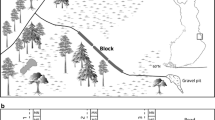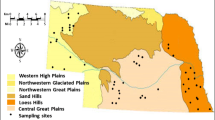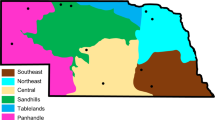Abstract
Establishing vegetation on roadsides following construction can be challenging, especially for relatively slow growing native species. Topsoil is generally removed during construction, and the surface soil following construction (“cut-slope soils”) is often compacted and low in nutrients, providing poor growing conditions for vegetation. Nebraska Department of Transportation (NDOT) protocols have historically called for nitrogen (N) and phosphorus (P) fertilization when planting roadside vegetation following construction, but these recommendations were developed for cool-season grass plantings and most current plantings use slower-establishing, native warm-season grasses that may benefit less than expected from current planting protocols. We evaluated the effects of nitrogen and phosphorus fertilization, and also topsoil amendment, on the foliar cover of seeded and non-seeded species planted into two post-construction roadside sites in eastern Nebraska. We also examined soil movement to determine how planting protocols and plant growth may affect erosion potential. Three years after planting, we found no consistent effects of N or P fertilization on foliar cover. Plots receiving topsoil amendment had 14% greater cover of warm-season grasses, 10% greater total foliar cover, and 4–13% lower bare ground (depending on site) than plots without topsoil. None of the treatments consistently affected soil movement. We recommend that NDOT change their protocols to remove N and P fertilization and focus on stockpiling and spreading topsoil following construction.





Similar content being viewed by others
References
Anderson BE (2007) Establishing dryland forage grasses. University of Nebraska-Lincoln Extension, Lincoln, NE, NebGuide G1705
Barnhart S (1996) Warm-season grasses for hay and pasture. Iowa State University, Ames, Iowa, Cooperative Extension Service, PM-569
Berg WA (1995) Response of a mixed native warm-season grass planting to nitrogen fertilization. J Range Manage 48:64–67. https://doi.org/10.2307/4002506
Black AL (1968) Nitrogen and phosphorus fertilization for production of crested Wheatgrass and native grass in Northeastern Montana. Agron J 60:213–216. https://doi.org/10.2134/agronj1968.00021962006000020021x
Blumenthal DM, Jordan NR, Svenson EL (2005) Effects of prairie restoration on weed invasions. Agric Ecosyst Environ 107:221–230
Brady NC, Weil RR (1999) The nature and properties of soils, 12th edn. Prentice-Hall, Inc, Upper Saddle River, New Jersey
Burke IC, Lauenroth WK, Coffin DP (1995) Soil organic matter recovery in semiarid grasslands: Implications for the conservation reserve program. Ecol Appl 5:793–801
Claassen VP, Marler M (1998) Annual and perennial grass growth on nitrogen-depleted decomposed granite. Restor Ecol 6:175–180. https://doi.org/10.1111/j.1526-100X.1998.00629.x
Claassen VP, Zasoski RJ (1994) The effects of topsoil reapplication on vegetation reestablishment. California Department of Transportation, Sacramento (CA)
Gillen RL, Berg WA (1998) Nitrogen fertilization of a native grass planting in western Oklahoma. J Range Manage 51:436–441
Gillen RL, Rollins D, Stritzke JF (1987) Atrazine, spring burning, and nitrogen for improvement of tallgrass prairie. J Range Manage 40:444–447
Haigh MJ (1977) Use of Erosion Pins in the Study of Slope Evolution, Technical Bulletin 18. British Geomorphological Research Group
Hargis NE, Redente EF (1984) Soil handling for surface mine reclamation. J Soil Water Conserv 39:300–305
Heggenstaller AH, Moore KJ, Liebman M, Anex RP (2009) Nitrogen influences biomass and nutrient partitioning by perennial, warm-season grasses all rights reserved. No part of this periodical may be reproduced or transmitted in any form or by any means, electronic or mechanical, including photocopying, recording, or any information storage and retrieval system, without permission in writing from the publisher. Agron J 101:1363–1371. https://doi.org/10.2134/agronj2008.0225x
Hill JO, Simpson RJ, Moore AD, Chapman DF (2006) Morphology and response of roots of pasture species to phosphorus and nitrogen nutrition. Plant and Soil 286:7–19
Huxtable CHA, Koen TB, Waterhouse D (2005) Establishment of native and exotic grasses on mine overburden and topsoil in the Hunter Valley, New South Wales. Range J 27:73–88. https://doi.org/10.1071/RJ05006
Koide RT, Mooney HA (1987) Revegetation of serpentine substrates: Response to phosphate application. Environ Manage 11:563–567. https://doi.org/10.1007/bf01867662
McLendon T, Redente EF (1992) Effects of nitrogen limitation on species replacement dynamics during early secondary succession on a semiarid Sagebrush site. Oecologia 91:312–317. https://doi.org/10.2307/4220074
Muir JP, Sanderson MA, Ocumpaugh WR, Jones RM, Reed RL (2001) Biomass production of ‘alamo’ switchgrass in response to nitrogen, phosphorus, and row spacing research supported by the biofuels systems division under contract DE-AC05-84OR21400 to Oak Ridge Natl. Lab. managed by Martin Marietta energy systems. Agron J 93:896–901. https://doi.org/10.2134/agronj2001.934896x
Nebraska Department of Transportation (2017) NDOT roadside vegetation establishment and management. Lincoln, NE, USA
Packard S, Mutel CF (1997) The tallgrass restoration handbook. Island Press, Washington DC
Rehm GW (1990) Importance of nitrogen and phosphorus for production of grasses established with no-till and conventional planting systems. J Prod Agric 3:333–336. https://doi.org/10.2134/jpa1990.0333
Rehm GW, Moline WJ, Schwartz EJ (1972) Response of a seeded mixture of warm-season prairie grasses to fertilization. J Range Manage 25:452–456. https://doi.org/10.2307/3897006
SAS Institute Inc (2012) SAS 9.3, 9.3 edn., Cary, NC
Schacht WH, Soper J (2012) Adapting NDOR’s roadside seed mixture for local site conditions, project RHE-07, Final Report. Department of Agronomy and Horticulture, University of Nebraska-Lincoln, Lincoln, NE
Steinfeld DE, Riley SA, Wilkinson KM, Landis TD, Riley LE (2007) Roadside revegetation: An integrated approach to establishing native plants. Federal Highway Administration. Vancouver, WA, USA
Sullivan MJ, Daiber FC (1974) Response in production of cord grass, spartina alterniflora, to inorganic nitrogen and phosphorus fertilizer. Chesap Sci 15:121–123. https://doi.org/10.2307/1351275
USDA Natural Resources Conservation Service (2008) Soil quality indicators: bulk density. http://soils.usda.gov/sqi/assessment/files/bulk_density_sq_physical_indicator_sheet.pdf
Wienhold CE (2008) Research Statement of Need. Lincoln, NE, USA
Williams DW, Jackson LL, Smith DD (2007) Effects of frequent mowing on survival and persistence of forbs seeded into a species-poor grassland. Restor Ecol 15:24–33
Acknowledgements
We thank NDOT- Materials and Research Division for funding this project, NDOT District 1 for providing land and maintenance staff for site preparation and traffic control during project installation, Jason Henderson and Green Thumb LLC for installation of this project, and the staff, graduate and undergraduate students from the University of Nebraska-Lincoln for assisting with data collection.
Author information
Authors and Affiliations
Corresponding author
Ethics declarations
Conflict of interest
This study was funded by Nebraska Department of Transportation RHE-1 (Fertilizer Effects on Attaining Vegetation Requirements). Carol Wienhold is employed by Nebraska Department of Transportation.
Rights and permissions
About this article
Cite this article
Hillhouse, H.L., Schacht, W.H., Soper, J.M. et al. Effects of Nitrogen and Phosphorus Fertilizer and Topsoil Amendment on Native Plant Cover in Roadside Revegetation Projects. Environmental Management 61, 147–154 (2018). https://doi.org/10.1007/s00267-017-0946-9
Received:
Accepted:
Published:
Issue Date:
DOI: https://doi.org/10.1007/s00267-017-0946-9




